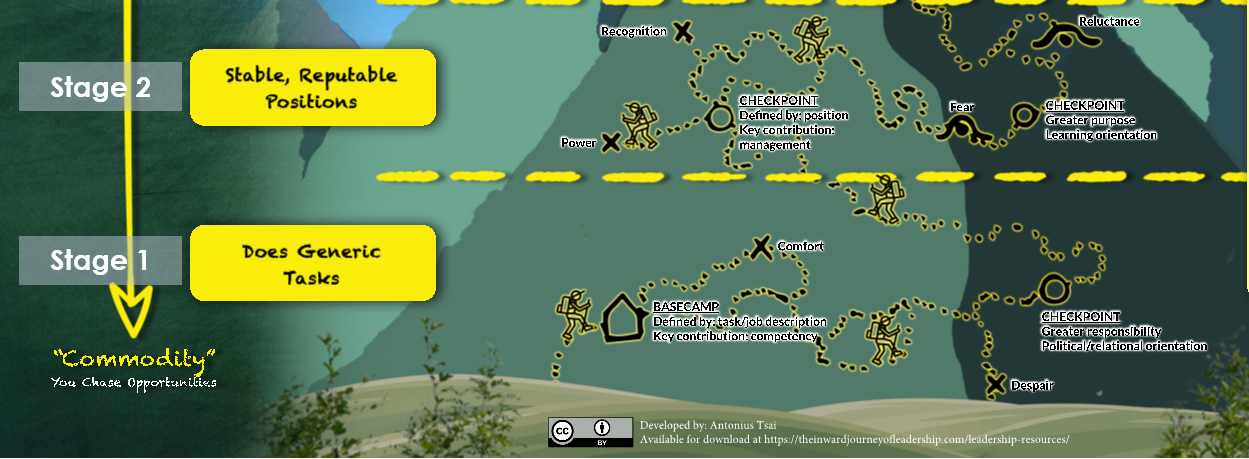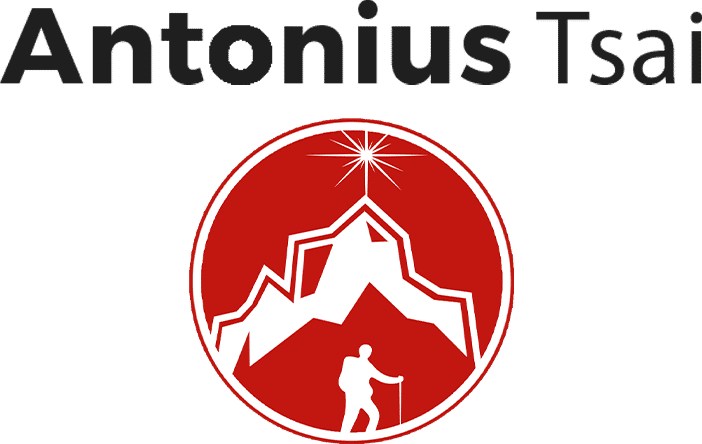The First Half of the Journey (Stages 1 and 2)
In the two previous posts, we discussed the two stages of the first half of the career: taking responsibility for oneself (Stage 1) and taking responsibility for others (Stage 2). Those who have navigated these two stages well will tend to be successful in the conventional sense. They will tend to be promoted, increase their earnings, and gain acceptance and credibility among their professional communities. They have entered the stage of “stable, reputable positions”.

I work with many mid-to-senior level administrators, and they are generally good, well-intentioned people who want to make a difference. However, most of them are also stuck. They have many progressive ideas that they would like to implement, but the demands of their administrative role occupies 80% to 90% of their attention. They think, “After this emergency, then I’ll get to my own agenda.” They also think, “If I had a higher position, then I’ll have more power to implement my agenda.” However, in real life, one emergency follows another, and a promotion just means the need to deal with larger emergencies.
The Transition to the Second Half of the Journey (Stages 3 and 4)
Somewhere in your 40’s, something begins to happen. A new perspective begins to emerge. You’ve been around the block now and have seen what there is to see. Some of the things that you used to be infatuated with begin to lose their luster. You also realize that you are getting closer than ever to the end of your career. An inner voice urges you to start doing whatever it is that you were meant to be doing…ASAP.
Now, I must be candid in that most people do not heed this inner calling. People do their best to distract themselves; they can use tactics such as going on exotic trips, buying a new toy, changing spouses, or doubling down on their career achievement ambitions. Anything to avoid having to reflect on their true purpose.
In wanting to guide people in the right direction, life will often send a “wake-up call”. This wake-up call can take the form of disruptions in relationships, accidents, health emergencies, or anything that will jar someone out of their current state of inertia. Pssst, wake up, it’s time to keep moving!
Stage 3: Developing Leadership and Taking Responsibility for Purpose
Returning to our mountain-climbing story… You and you group are now getting rather far up. You notice that there is no one else near you. Most people have finished their recreational hike and have turned back. You know that the summit is still a ways away, and test of the journey will be challenging (and potentially dangerous). You and your group decide to push on. The mountain is calling you.
Minutes later, a member of your group slips on the trail and almost falls over a steep drop. You grab her just in time. You question whether this journey is really worth the risk. You ask yourself, “Why am I REALLY doing this? What challenges will I need to overcome to make it?”
You don’t climb the second mountain the way you climb the first mountain. You conquer your first mountain. You identify the summit, and you claw your way toward it. You are conquered by your second mountain. You surrender to some summons, and you do everything necessary to answer the call and address the problem or injustice that is in front of you. On the first mountain you tend to be ambitious, strategic, and independent. On the second mountain you tend to be relational, intimate, and relentless.
~ David Brooks, The Second Mountain: The Quest for a Moral Life

In Stage 3, you go beyond the more superficial motivations in your career and focus on deeply contributing to something meaningful to you. In the process, you will encounter challenges and danger which will demand that you to access your deepest values and strengths.
Focus on Internal Commitments
In the first half of the journey, one’s motivations tend towards the more extrinsic, such as, recognition, achievement, money, or just the desire to prove yourself to others. If you think about it, anyone can want money or recognition, those are not unique to you or your deepest wants.

In the second half of the journey, you must ask yourself, “What do I REALLY want?”
I work with many doctors, and occasionally, I would encounter one with an almost super-human commitment to healing. More often than not, when I dig deeper into that person’s life, I find that they have suffered a deep wound, and that wound has given them a purpose to heal themselves and to heal others.
You must examine your life for clues; recall the times where you were deeply pained and wanted to heal that pain. Those are the pains that you will want to heal in yourself and others. You will find that what you really want is to be of service to others in a way that is fitting to your unique life story. Those are the actions which will fulfill you.
The meaning of life is to find your gift. The purpose of life is to give it away. ~ Pablo Picasso
Leverage Personal Talents
In the first half of the journey, we seek to be well-rounded. We learn our reading, writing, and arithmetic as school children. We then choose a professional discipline and learn the basic knowledge and skills for that field. Fundamental knowledge and skills are indeed necessary for us, but is only half of what we need.
Most of the challenges you face in the second half of the journey are not solving basic math problems or applying novice concepts. How do you change the culture of an organization? How do you enlist support for a controversial but needed effort? How do set a strategic direction for an organization to escape financial disaster?
While well-rounded, general skills can overcome well-rounded, general challenges, major challenges can only be conquered by leveraging your best self. You can no longer be a jack-of-all trades, but must have a mastery of something. At this point you must identify your greatest talents and strengths and focus your efforts on using those in overcoming the major challenges that you will encounter in this stage.
What are you really really good at? How can that talent be applied to your major challenge?
Generate A Compelling Vision
Some people choose “to go to college” rather than choose “to be educated” or choose “to eat health foods” rather than choose “to be healthy.” Because this kind of choice invests undue power in the process, the result is inextricably tied to the process, and the ways in which the desired result can come about are limited.
~ Robert Fritz, The Path of Least Resistance: Learning to Become the Creative Force in Your Own Life
In the first half, people who navigate the stages well are generally driven by a strong process. They study hard, or they exercise regularly, or they are deliberate in their approach to people. A strong process is good, but a strong vision is more powerful. As in the quote above, it’s good to choose to go to college (process), but it’s much more powerful to choose to be educated (vision).

In the movie The Empire Strikes back, there was a scene where Luke Skywalker tries to use force power to pull his moored X-wing fighter from a swamp. He tells his mentor, Yoda that he will try. He fails. Yoda gives him this teaching: Try not. Do. Or do not. There is no try.
Elon Musk, when asked about the difficulties of creating a space rocket company, he replied, “I don’t create companies for the sake of creating companies, but to get things done.” It’s not about trying to create a space rocket company (process); it’s about “going out there and being among the stars.”(vision)
In my interactions with people, I notice that they are generally willing to execute a process (e.g. meet bi-weekly on a topic) but very few are willing to commit to a vision (X result by Y time). In the second half, leaders must be able to go beyond putting time into a process and move towards achieving a committed vision.
Summary of Career Stage 3: Purpose
The transition from Stage 2 to Stage 3 represents a major shift in life orientation. In Stages 1 and 2, we take the world as given, as larger than us. We then adapt ourselves to the world. In Stages 3 and 4, we begin to have the ability to change the world.
This process involves an inward orientation. Rather than accepting the generic wants of society, you identify your unique wants. Rather than relying on general skills, you leverage your unique talents. Rather than putting in hours, you commit to a vision. You, through your life, are perfectly suited to handle a major challenge that only you can handle. In handling that challenge, you change yourself and the world for the better.
Determination, energy, and courage appear spontaneously when we care deeply about something. We take risks that are unimaginable in any other context.
~Margaret Wheatley
